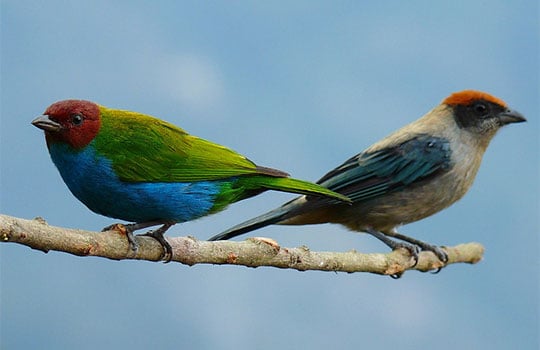
Five Colombian reserves to coexist with birds
We suggest five places where you can enjoy the magical experience of wild bird-watching in Colombia.
Colombia is known all over the world as one of the most bio-diverse countries on the planet, and, in view of that richness, several nature reserves and parks offer hikes and guided tours to observe the majesty of these species in their natural environment. Here are five recommended spots for studying birdlife in different parts of the country. (You may also like to read: Colombia from the air)
El Almejal Nature Reserve
This is a complex of cabanas situated in the middle of the Solano Bay and the Utría Cove national park, in Chocó, the area with the highest number of species per square meter in the world. The reserve, as well as being home to almost 800 species of birds that can be seen all year round, has a location that allows visitors on each tour to behold marvelous landscapes and four primary ecosystems: coral, mangrove, rainforest and sea.
El Almejal offers accommodation and tourism plans to explore the region in one or more days, accompanied by expert guides. Visitors will be a very close to birds such as the great curassow, the blue cotinga and the splendid Baudó oropendola, unique bird in the world and the star of this magical virgin neotropical rainforest.

La Florida regional park
Those who are in the center of the country will find more than 200 hectares of reserve in the La Florida park, just 20 minutes from Bogotá. It is ideally placed for visitors to get a change of scenery, experience a magnificent lake and enjoy the fresh air and the sounds of nature.
The conditions of this ecosystem (wetlands) are ideal for hosting around 75 species of birds, including the Bogotá rail, the bicolored wren, the rufous-browed conebill and the silvery-throated spinetail. Visitors have the option of joining a guided tour led by ornithological experts and entering the lakeside observatory to enjoy the beauty and the birds singing.
Though the park is open every day, visits are scheduled on weekends from 6 a.m. to 6 p.m. these are free of charge and are available for groups of up to 30 people.
Pauxi Pauxi Natural Bird Reserve
The Pauxi Pauxi Natural Bird Reserve was opened in 2007 with the aim of conserving the habitat of the helmeted curassow, an endangered species endemic to the area. Situated two and a half hours from Bucaramanga on the Cerro de la Paz, it is the perfect spot to see species like the chestnut-bellied hummingbird, the saffron-headed parrot, the white-mantled barbet and the cerulean warbler.
It also hosts several streams and captivating landscapes, notable among which is the historical stone trail built by German trader Geo Von Lengerke in 1840. Those wishing to stay for a few days are free to do so there are on-site facilities with electricity and drinking water that can host groups of up to four people.
Amacayacú National Natural Park
If you have a sense of adventure, the Amazon is for you. With more than half of Colombia's 1,889 known bird species living in the area, it is one of the most fascinating destinations for lovers of biodiversity.
Where exactly can you go? To the Amacayacú National Park: 293,500 hectares of reserve where visitors will find themselves face to face with 20 different species of parrots, antbirds, woodcreepers, macaws and budgerigars native to the rainforest.
In addition, there is a visitor center where accommodation is available and from where tourists can opt to take part in other activities, like soaking up local culture and the natural richness offered by the "lungs of the planet."
Don't forget to check the weather before traveling during the rainy season, the activities can be canceled and spaces are restricted due to security reasons. (You may also like to read: The six best places to camp in Colombia)
Chincherry Natural Bird Reserve
The archipelago of San Andrés and Providencia is on the route of various migratory birds that come from the north, and forms part of the Seaflower Biosphere Reserve. It is also the home of a number of native species, notable among which are the San Andrés vireo, known locally as the chincherry, which lends its name to this reserve where visitors can coexist with nature.
This region, which hosts a remarkable number of mangroves, features ideal conditions for watching birds and other animals. As part of this, there is also a strategy in place to educate islanders and visitors on the importance of looking after the environment so as to conserve the flora and fauna of this marvelous ecosystem.
Although the reserve does not have its own accommodation, the island offers options for all tastes and budgets. Visitors are bound to find a perfect option for enjoying the nature around the sea of seven colors. (You may also like to read: Colombia's paradise islands)
This is just an appetizer. The diversity of climates and landscapes let visitors coexist with nature in different corners of the country all year round. Be bold and let the birds sweep you off your feet. In Colombia, the magic is also in the sky.
 Welcome, you are in
Welcome, you are in 



